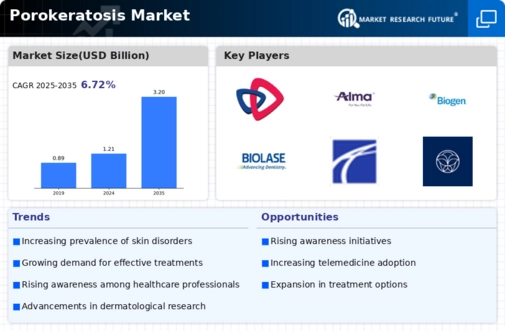Market Share
Porokeratosis Market Share Analysis
The Porokeratosis market is in the dermatology and skincare industry, using numerous strategies to capture market share and address the peculiar problems associated with this skin condition. This involves primarily product development as one of the distinguished strategies in marketing. By means of research and development, organizations strive hard to come up with advanced treatments for Porokeratosis that are more effective, have reduced side effects and promote patient comfort. In order to come up with new solutions, companies aim at establishing a unique brand which will help them grasp a large proportion of the Porokeratosis treatment market.
Pricing strategy also plays a crucial role in market share positioning within the Porokeratosis market. Competent pricing or value-based pricing models can be used by firms so as to reach different patients. Competitive pricing may be chosen by some businesses to expand their consumer base while others would like to emphasize on premium pricing that is justified by exclusive product attributes among other factors. Finding an affordable price range for customers’ perception about quality is important since many patients suffering from Porokeratosis have diverse economic backgrounds.
Also key in the Porokeratosis industry are partnerships /collaborations. Often times companies go into alliances with research institutions, dermatologists or even other pharmaceutical companies so as pool resources and expertise. Cooperation like this may lead to quickened improvement of new treatments, enlarged markets as well as strengthened distribution channels across markets. Partnerships offer a more holistic approach towards managing Porokeratosis through bringing together different stakeholders involved in dealing with challenges such as research, development and market access.
Proper marketing and branding strategies contribute significantly when it comes to gaining wider market shares within the Porokeratosis segment; these comprehensive marketing efforts entail highlighting benefits accruing from products to both health care practitioners and consumers hence building trust among them over time through provision of correct information about it especially during campaigns meant for educating people found all over world starting right from the public awareness campaigns, online platforms to the dermatology conferences.
Geographical expansion also plays a role in strategic planning for Porokeratosis segment in order to maintain their market position. Identifying regions with high prevalence rates and developing strategies that align with specific regional needs is vital. For example, successful penetration of new markets across different cultural and regulatory environments may require modification of products, distribution channels and methods of promotion aimed at addressing challenges associated with global Porokeratosis treatment.
Sustained investment in post-market surveillance, safety monitoring and patient support programs is required if market share within the Porokeratosis segment should be maintained or grown further. Regular monitoring regarding product safety and efficiency coupled by patients’ education and support programs makes health care providers as well as patients have faith in them. Such a commitment towards safety and support ensures that customers are loyal to a particular brand for an extended period resulting into future success in the market.













Leave a Comment